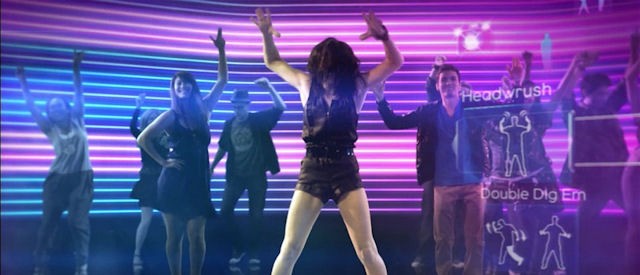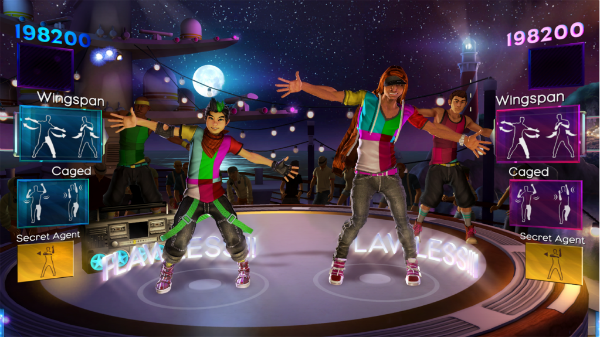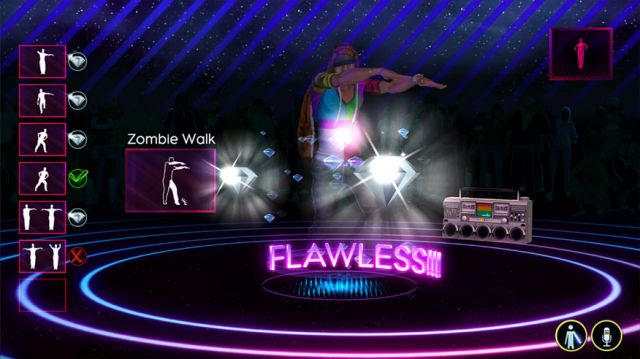

The first Dance Central showed the world what Kinect could really do. With realistic dance recognition, a good library of songs, and great gesture controls, it was the launch title to get. The only problem? Multiplayer was limited to Dance Battles in which players awkwardly took turns performing parts of a song. With another year of development time, Dance Central 2 steps it up with proper multiplayer, a lil’ story mode, and even more songs to dance with.
In case you are new to the wonders of Kinect, the Dance Central games are honest-to-goodness dancing simulators with some videogaming elements thrown on top. Konami’s Dance Dance Revolution and Dance Masters are simple rhythm games that involve some dance-like steps, and Just Dance 3 is more focused on moving around and being silly than perfecting steps. Those games may be fun for what they are, but Dance Central 2 is the for real deal – every song has genuine dance moves that players need to learn and bust out in order to succeed. The higher the difficulty, the more moves to perform.

Two visual cues indicate which steps to take. First off, dance cards scroll up the side of the screen, displaying a drawing of each move and its name. Their main benefit is communicating what moves are coming up next. But they’re difficult to rely on entirely because the drawings don’t always represent every part of a move, plus they sometimes scroll by too quickly to read easily. The on-screen dancers are more useful for dancing on the fly. As they perform each move, it’s your job to imitate them as closely as possible. If part of the dancer’s body glows with a red outline, that part of the player’s body is out of alignment.
The dancing in DC2 works just like it did before, but with some extra flourishes. The on-screen dancers’ limbs glow with motion blur as they strut their stuff, making it easier to focus on what parts of your body need to be movin’. Also new are yellow dance cards. When one of these pops up between the regular dance cards, the move is worth four times as many points as normal. I like how they make certain moves more critical than others.
The Dance Central games are serious dance simulators, which means they can be seriously difficult at times. When you’ve got friends over for co-op or competitive dancing, they’re not going to want to learn the moves before they start playing. Thankfully Easy difficulty is simple and forgiving enough that failing won’t be a concern; I usually earned four- and five-star ratings on my first attempts. Normal and especially Hard difficulties require much more coordination and practice, though.

Break it Down is where you’ll go to learn those tough routines - at your own pace and without fear of failing. As you try to perform each move three times, the narrator provides audio cues to help you pick it up. DC2 significantly improves on the original Break it Down mode by letting you focus on specific moves instead of tackling all of them in linear order. You can also jump back and forth between moves at any time. Slowing down moves to learn their finer points is easier than ever thanks to voice controls… when they work. More on that in a bit.
The first Dance Central consisted solely of picking songs from a menu with no metagame to tie everything together. The lack of motivation kept me from coming back to it as much as I should've. In DC2, you can still dance one song at a time by picking Dance from the main menu, and even make playlists if you like. But the sequel really ups the ante with Crew Challenge, an honest-to-goodness story mode. Here players take on the role of an up-and-coming dancer. In order to rise through the ranks, you’ll need to impress each of the game’s five-ish dance crews by performing several of that crew’s routines (songs). You can get by with as few as five songs per crew or put your back into it and do all nine of their songs for the associated Achievements.
For the most part, there’s not much of a story other than the crews introducing themselves and congratulating you when you complete their Final Challenges. But beat the fifth crew, the Euro-snob Glitterati, and you’ll learn that someone's been pulling the strings behind the scenes. This leads to a climactic final challenge that you should not allow anyone to spoil for you. I loved the structure of Crew Challenge mode and look forward to tackling the higher difficulties some day.
Every crew is made up of two people, and for good reason. All three of DC2’s modes - Crew Challenge, Dance, and Fitness (which enables calorie counting throughout the game and also offers a batch of timed playlists) – support 2-player local co-op. Both players stand side-to-side, so you’ll need a fair amount of space to avoid bumping into each other. The two players’ combined performance determines their shared star rating at the end of the song. Co-op dances work the same way as single-player; there aren’t any special co-op routines. But it’s so much more fun to get up and moving with another person. Co-op makes Dance Central 2 the party game it always deserved to be. Another plus: unlike Just Dance 3, both players here can earn Achievements!
As wonderful as cooperative dancing is, a little competition never hurt things either. DC2’s revised Dance Battles really hit the mark. After you and your partner choose a song (no AI Dance Battles here), it’s time to outdo one another. In addition to simultaneously dancing as normal, each person gets a few solo turns under the spotlight. I like those moments but the new Free-4-All bits are even better. They add improv to an otherwise rigid set of routines. Four dance cards pop up in the center of the screen for both players to perform as they see fit. Too bad Free-4-Alls don’t appear in co-op too, as they would still work even without the competitive element.
One area where Dance Central clearly excelled over other Kinect launch titles was its slick menu system. Like the first game, DC2 has some of the slickest motion-controlled menus around. No highlighting options and waiting an eternity for them to activate here! Instead, you move the cursor up and down with your right hand and then slide it left to select things. The left hand conveniently controls backing up between menus in similar fashion. You can also use a controller to navigate menus, an option I wish all Kinect games supported.
New to DC2 are voice commands. You could potentially rely on voice commands for the entire menu system, though they’re best suited to Break it Down mode, where players are least likely to be holding a controller. Unfortunately, the voice commands just didn’t work consistently for me. I often had to repeat myself twice or more in order to make selections, which is miles away from ideal. I don’t have similar problems using voice with the Xbox dashboard or Netflix, so DC2 seems to be at fault. It will be interesting to see whether other gamers run into the same issues.
Dance Central 2 is a must-buy for Kinect owners who like to entertain. With 45 songs on-disc, the ability to export the first game’s 32 tracks for just five bucks, and plenty of downloadable songs to purchase on top of that, DC2 has ample staying power. Even if you’re still satisfied with the first game’s selection of songs, the addition of co-op makes this sequel a necessary purchase. Why should you and your partner take turns when you can bring it on together?